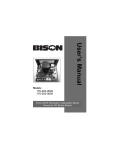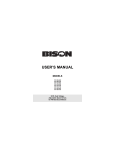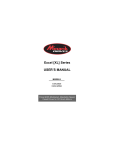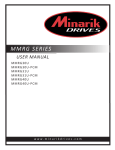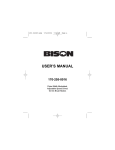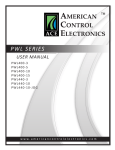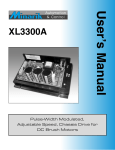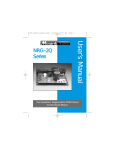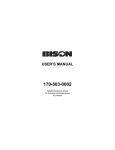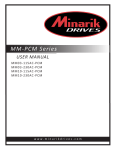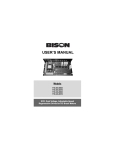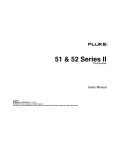Download USER`S MANUAL - Bison Gear and Engineering Corporation
Transcript
USER’S MANUAL Models: 170-243-0003 170-243-0010 Pulse-Width Modulated, Adjustable Speed, Cased Drives for DC Brush Motors Copyright © 2006 by Bison Gear & Engineering All rights reserved. No part of this manual may be reproduced or transmitted in any form without written permission from Bison Gear & Engineering. The information and technical data in this manual are subject to change without notice. Bison Gear & Engineering and its Divisions make no warranty of any kind with respect to this material, including, but not limited to, the implied warranties of its merchantability and fitness for a given purpose. Bison Gear & Engineering and its Divisions assume no responsibility for any errors that may appear in this manual and make no commitment to update or to keep current the information in this manual. MVD062402 Printed in the United States of America. i Safety Warnings SHOCK HAZARD AVOID HEAT KEEP DRY AVOID VIBRATION • denotes an important safety tip or warning. This symbol Please read these sections carefully prior to performing any of the instructions contained in that section. • Have a qualified electrical maintenance technician install, adjust and service this equipment. Follow the National Electrical Code and all other applicable electrical and safety codes, including the provisions of the Occupational Safety and Health Act (OSHA), when installing equipment. • Reduce the chance of an electrical fire, shock, or explosion by proper grounding, over-current protection, thermal protection, and enclosure. Follow sound maintenance procedures. It is possible for a drive to run at full speed as a result of a component failure. Bison strongly recommends the installation of a master switch in the main power input to stop the drive in an emergency. Circuit potentials are at 115 VAC above earth ground. Avoid direct contact with the printed circuit board or with circuit elements to prevent the risk of serious injury or fatality. Use a non-metallic screwdriver for adjusting the calibration trimpots. Use approved personal protective equipment and insulated tools if working on this drive with power applied. ii Contents Safety Warnings . . . . . . . . . . . . . . . . . . . . . . . . . . . . . . . . . . . . . . . . . . .i Specifications . . . . . . . . . . . . . . . . . . . . . . . . . . . . . . . . . . . . . . . . . . . .1 Dimensions . . . . . . . . . . . . . . . . . . . . . . . . . . . . . . . . . . . . . . . . . . . . . . .5 Installation Mounting . . . . . . . . . . . . . . . . . . . . . . . . . . . . . . . . . . . . . . . . . . . . . .7 . . . . . . . . . . . . . . . . . . . . . . . . . . . . . . . . . . . . . . . . . . . . . . . . . . . .7 Connections . . . . . . . . . . . . . . . . . . . . . . . . . . . . . . . . . . . . . . . . . . . . . . . . . .9 Shielding guidelines . . . . . . . . . . . . . . . . . . . . . . . . . . . . . . . . . . . . . . .12 Field Output . . . . . . . . . . . . . . . . . . . . . . . . . . . . . . . . . . . . . . . . . . . . . . . . .13 Fusing . . . . . . . . . . . . . . . . . . . . . . . . . . . . . . . . . . . . . . . . . . . . . . . . . . . . . .14 Line Fusing Drives . . . . . . . . . . . . . . . . . . . . . . . . . . . . . . . . . . . . . . . . . . . .15 Voltage Follower . . . . . . . . . . . . . . . . . . . . . . . . . . . . . . . . . . . . . . . . . . . . . .16 Terminal Block . . . . . . . . . . . . . . . . . . . . . . . . . . . . . . . . . . . . . . . . . . . . . . .17 Operation . . . . . . . . . . . . . . . . . . . . . . . . . . . . . . . . . . . . . . . . . . . . . . .18 Before applying power: . . . . . . . . . . . . . . . . . . . . . . . . . . . . . . . . . . . . . . . .18 Startup . . . . . . . . . . . . . . . . . . . . . . . . . . . . . . . . . . . . . . . . . . . . . . . . . . . . .19 Diagnostic LEDs . . . . . . . . . . . . . . . . . . . . . . . . . . . . . . . . . . . . . . . . . . . . . .19 Line starting and line stopping . . . . . . . . . . . . . . . . . . . . . . . . . . . . . . . . . . .21 Inhibit circuit . . . . . . . . . . . . . . . . . . . . . . . . . . . . . . . . . . . . . . . . . . . . . . . . .21 Decelerating to minimum speed Dynamic braking . . . . . . . . . . . . . . . . . . . . . . . . . . . . . . . . .23 . . . . . . . . . . . . . . . . . . . . . . . . . . . . . . . . . . . . . . . . . . . . .24 Calibration . . . . . . . . . . . . . . . . . . . . . . . . . . . . . . . . . . . . . . . . . . . . . .26 MINIMUM SPEED (MIN SPD) . . . . . . . . . . . . . . . . . . . . . . . . . . . . . . . . . . .27 MAXIMUM SPEED (MAX SPD) . . . . . . . . . . . . . . . . . . . . . . . . . . . . . . . . . .27 ACCELERATION (ACCEL) . . . . . . . . . . . . . . . . . . . . . . . . . . . . . . . . . . . . .28 DECELERATION (DECEL) . . . . . . . . . . . . . . . . . . . . . . . . . . . . . . . . . . . . .28 IR COMPENSATION (IR COMP) . . . . . . . . . . . . . . . . . . . . . . . . . . . . . . . . .29 iii CURRENT LIMIT (CURR LIMIT) 170-243-0003 or TORQUE LIMIT (TORQ LIMIT) 170-243-0010 . . . . . . . . . . . . . . . . . . . . . . .30 Calibration with low voltage DC motors . . . . . . . . . . . . . . . . . . . . . . . . . . . .32 Application Notes . . . . . . . . . . . . . . . . . . . . . . . . . . . . . . . . . . . . . . . .34 Leader-follower application . . . . . . . . . . . . . . . . . . . . . . . . . . . . . . . . . . . . .34 Single speed potentiometer control of multiple drives . . . . . . . . . . . . . . . . .35 Troubleshooting . . . . . . . . . . . . . . . . . . . . . . . . . . . . . . . . . . . . . . . . . .36 Before troubleshooting . . . . . . . . . . . . . . . . . . . . . . . . . . . . . . . . . . . . . . . . .36 Certificate of Compliance . . . . . . . . . . . . . . . . . . . . . . . . . . . . . . . . .40 AC Line Filters . . . . . . . . . . . . . . . . . . . . . . . . . . . . . . . . . . . . . . . . . . . . . . .40 Unconditional Warranty . . . . . . . . . . . . . . . . . . . . . .inside back cover Tables Table Table Table Table 1. 2. 3. 4. Field Output Connections . . . . . . . . . . . . . . . . . . . . . . . . . . . . . . . . . . . .13 Fuse Chart . . . . . . . . . . . . . . . . . . . . . . . . . . . . . . . . . . . . . . . . . . . . . . .15 Recommended Dynamic Brake Resistor Sizes . . . . . . . . . . . . . . . . . . .25 AC Line Filters . . . . . . . . . . . . . . . . . . . . . . . . . . . . . . . . . . . . . . . . . . . .41 iv Illustrations Figure Figure Figure Figure Figure Figure Figure Figure Figure Figure Figure Figure Figure Figure Figure 1. 170-243-0003 Dimensions . . . . . . . . . . . . . . . . . . . . . . . . . . . . . . . . . . . .5 2. 170-243-0010 Dimensions . . . . . . . . . . . . . . . . . . . . . . . . . . . . . . . . . . . .6 3. 170-243-0003 Connections . . . . . . . . . . . . . . . . . . . . . . . . . . . . . . . . . . .9 4. 170-243-0010 Connections . . . . . . . . . . . . . . . . . . . . . . . . . . . . . . . . . .10 5. Prewired Connections for Models 170-243-0003 and 170-243-0010 . .11 6. Voltage Follower Connections . . . . . . . . . . . . . . . . . . . . . . . . . . . . . . . .16 7. Cage-Clamp Terminal . . . . . . . . . . . . . . . . . . . . . . . . . . . . . . . . . . . . . .17 8. Voltage Switch Location . . . . . . . . . . . . . . . . . . . . . . . . . . . . . . . . . . . . .18 9. Diagnostic LED Location . . . . . . . . . . . . . . . . . . . . . . . . . . . . . . . . . . . .20 10. Inhibit Plug with Run/Coast to Zero Speed Switch . . . . . . . . . . . . . . .22 11. Run/Decelerate to Minimum Speed Switch . . . . . . . . . . . . . . . . . . . . .23 12. Dynamic Brake Connection . . . . . . . . . . . . . . . . . . . . . . . . . . . . . . . . .24 13. 170-243-0003 CURR LIMIT and IR COMP Settings . . . . . . . . . . . . . .31 14. 170-243-0010 TORQ. LIMIT and IR COMP Settings . . . . . . . . . . . . .31 15. 170-243-0003 MAX SPEED Settings for Low Voltage DC Motors . . . . . . . . . . . . . . . . . . . . . . . . . . . . . . . . . . . .32 Figure 16. 170-243-0010 MAX SPD Settings for Low Voltage DC Motors . . . . . . . . . . . . . . . . . . . . . . . . . . . . . . . . . . . .33 Figure 17. Leader-Follower Application . . . . . . . . . . . . . . . . . . . . . . . . . . . . . . . . .34 Figure 18. Single Speed Potentiometer Control of Multiple Drives . . . . . . . . . . . .35 1 Specifications Model Number 170-243-0003 Type: Cased NEMA Rating NEMA 4X AC Line Voltage 115 VAC/230 VAC, ±10%, 50/60 Hz, single phase Line Fuse Rating 8A Horsepower Range @ 130 VDC Output 1/20–1/3 HP Horsepower Range @ 240 VDC Output 1/8–1/2 HP Maximum Armature Voltage Range @ 115 VAC Input 50–130 VDC Maximum Armature Voltage Range @ 230 VAC Input 50–240 VDC Minimum Speed Adjustment Range @ 115 VAC Input 0–65 VDC Minimum Speed Adjustment Range @ 230 VAC Input 0–65 VDC Maximum Armature Current 3 ADC Field Voltage @ 115 VAC Input 50 VDC/100 VDC Field Voltage @ 230 VAC Input 100 VDC/200 VDC Maximum Field Current 1 ADC Form Factor 1.05 Acceleration Time Range (no load) for 0–130 VDC Armature Voltage Range 1–10 seconds for 0–240 VDC Armature Voltage Range 1–19 seconds Deceleration Time Range (no load) for 0–130 VDC Armature Voltage Range 3–9 seconds for 0–240 VDC Armature Voltage Range 4–19 seconds Analog Input Voltage Range (signal must be isolated; S1 to S2) for 0–130 VDC Armature Voltage 0–2.7 VDC for 0–240 VDC Armature Voltage 0–5.0 VDC 2 Speed Adjustment Potentiometer Approximate Input Impedance (from S1 to S2) Speed Regulation (at base speed) Weight Ambient Operating Temperature Range Vibration 10K ohms 100K ohms 1% 4.4 lb 10ºC–40ºC 0.5g max (0 – 50 Hz) 0.1g max (above 50 Hz) 3 Model Number Type NEMA Rating AC Line Voltage 170-243-0010 Cased NEMA 4X 115 VAC/230 VAC, ±10%, 50/60 Hz, single phase Line Fuse Rating 15 A Horsepower Range @ 130 VDC Output 1/4–1 HP Horsepower Range @ 240 VDC Output 1/4–2 HP Maximum Armature Voltage Range @ 115 VAC Input 50–130 VDC Maximum Armature Voltage Range @ 230 VAC Input 50–240 VDC Minimum Speed Adjustment Range @ 115 VAC Input 0–120 VDC Minimum Speed Adjustment Range @ 230 VAC Input 0–120 VDC Maximum Armature Current 10 ADC Field Voltage @ 115 VAC Input 50 VDC/100 VDC Field Voltage @ 230 VAC Input 100 VDC/200 VDC Maximum Field Current 1 ADC Form Factor 1.05 Acceleration Time Range (no load) for 0–130 VDC Armature Voltage Range 1–10 seconds for 0–240 VDC Armature Voltage Range 1–15 seconds Deceleration Time Range (no load) for 0–130 VDC Armature Voltage Range 1–10 seconds for 0–240 VDC Armature Voltage Range 1–19 seconds Analog Input Voltage Range (signal must be isolated; S1 to S2) for 0–130 VDC Armature Voltage 0–2.7 VDC for 0–240 VDC Armature Voltage 0–5.0 VDC Speed Adjustment Potentiometer 10K ohms 4 Approximate Input Impedance (from S1 to S2) 50K ohms Speed Regulation (at base speed) 1% Weight 7.4 lb Ambient Operating Temperature Range 10ºC–40ºC Vibration 0.5g max (0 – 50 Hz) 0.1g max (above 50 Hz) 5 Dimensions 6.90 [175] 0.91 [23] 40 30 20 10 0 50 60 70 80 90 100 7.78 [197] 8.20 [207] 6.00 [152] FOUR MOUNTING SLOTS 0.19 [5] WIDE 4.43 [112] 3.29 [83] 1.92 [49] 0.13 [3] 2.50 [63] TWO 0.88 [22] KNOCKOUTS ALL DIMENSIONS IN INCHES [MILLIMETERS] Figure 1. 170-243-0003 Dimensions 6 6.90 [175] 6.30 [159] 40 30 20 10 0 1.37 [35] 50 60 70 80 90 100 10.22 [259] 9.75 [247] 7.00 [177] FOUR MOUNTING SLOTS 0.19 [5] WIDE 5.79 [146] 4.69 [119] 1.45 [37] 2.31 [58] 1.50 [38] 1.50 [38] 0.12 [3] THREE 0.88 [22] KNOCKOUTS ALL DIMENSIONS IN INCHES [ MILLIMETERS] Figure 2. 170-243-0010 Dimensions 7 Installation Mounting Nema 4X cased drives come with 0.88 inch (22 mm) conduit knockout holes at the bottom of the case. The units may be vertically wall mounted using the four 0.19 inch (5 mm) slotted holes on the attached heat sink. For motor loads less than 5 ADC, the drive may be bench mounted horizontally, or operated without mounting. 1. Install the mounting screws through the drive’s four mounting slots. 2. For access to the terminal strip, turn the slotted screw on the front cover counterclockwise until it is free from the case. The right side of the cover is hinged to the case. Pull the slotted screw to open the case. 3. Carefully remove the 0.88 inch (22 mm) conduit knockouts by tapping them into the case and twisting them off with pliers. 4. Install conduit hardware through the knockout holes. Connect external wiring to the terminal block. 8 5. Grasp the slotted screw and tilt the front cover back into place. Avoid pinching any wires between the front cover and the case. 6. Turn the slotted screw clockwise until tight to secure the front cover. 7. Set the POWER switch to the OFF position before applying the AC line voltage. 9 Connections Bison drives supply motor voltage to terminals A1 and A2 (A1 is positive with respect to A2). It is assumed throughout this manual that the driven motor will rotate clockwise (CW) while looking at the output shaft protruding from the front of the motor. If the opposite is desired, simply reverse the wiring of A1 and A2 with each other. TB501 L1 115 230 F1 F2 A2 A1 115 Motor AC Line Voltage 115 or 230 VAC 230 + Field Output Shunt wound motors only. See Field Output section for connections. Figure 3. 170-243-0003 Connections Armature Output 10 POWER ON CURR LIMIT PS4 PS2 PS1 PS3 IL501 IL502 SO502 S0503 POWER CURR SO504 +15 C505 SO501 INHIBIT MIN SPD DECEL S1 ACCEL S2 S3 TB501 L1 230 115 F+ FAST-ACTING FUSE ONLY FU502 FAST-ACTING FUSE ONLY FU502 FAST-ACTING FUSE ONLY FU501 MAX SPD TORQ. LIMIT IR COMP JOG SPD SPD JOG IN SPD 230 115 JOG SPD and SPD IN are prewired for speed adjust poteniometer control. A1 F- To control speed with JOG trimmer potentiometer, connect SPD IN to JOG. A2 Motor will not turn if there is no connection to SPD IN. TB501 L1 SPD IN A2 F+ A1 F- A2 230 Motor Armature Output AC Line Voltage 115 or 230 VAC 115 Field Output Shunt wound motors only. See Field Output section for connections. Figure 4. 170-243-0010 Connections 11 Power Switch PS1 black black/white PS2 Power Light PS3 S1 S2 S3 white violet brown white/black CW 10K ohm Speed Adjust Potentiometer grey Figure 5. Prewired Connections for Models 170-243-0003 and 170-243-0010 PS4 12 Shielding guidelines Warning Under no circumstances should power and logic leads be bundled together. Induced voltage can cause unpredictable behavior in any electronic device, including motor controls. As a general rule, Bison recommends shielding of all conductors. If it is not practical to shield power conductors, Bison recommends shielding all logic-level leads. If shielding is not practical, the user should twist all logic leads with themselves to minimize induced noise. It may be necessary to earth ground the shielded cable. If noise is produced by devices other than the drive, ground the shield at the drive end. If noise is generated by a device on the drive, ground the shield at the end away from the drive. Do not ground both ends of the shield. If the drive continues to pick up noise after grounding the shield, it may be necessary to add AC line filtering devices, or to mount the drive in a less noisy environment. Logic wires from other input devices, such as motion controllers and PLL velocity controllers, must be separated from power lines in the same manner as the logic I/O on this drive. 13 Field Output The field output is for shunt wound motors only. Do not make any connections to the field output when using a permanent magnet motor. Table 1 shows where to connect the field leads of a shunt wound motor. Table 1. Field Output Connections Line Voltage (VAC) Approximate Field Voltage (VDC) 170-243-0003 Connections 170-243-0010 Connections 115 50 F1 and L1 F+ and L1 115 100 F1 and F2 F+ and F- 230 100 F1 and L1 F+ and L1 230 200 F1 and F2 F+ and F- Use 16 AWG wire to connect the field output to a shunt wound motor. 14 Fusing 170-243-0003: This drive comes with two 8A fuses installed (FU501 and FU502). FU501 connects with the L1 terminal (the hot leg of the AC line voltage). FU502 connects with the 230 terminal. If the current rating of the motor is less than the maximum current rating of the drive, replace the fuse with a lower rated one. Rate fuses at 150% times the maximum armature current. 170-243-0010: This drives comes with two 15A fuses installed (FU501 - FU502). FU501 connects with the L1 terminal (the hot leg of the AC line voltage). FU502 connects with the 230 terminal. If the current rating of the motor is less than the maximum current rating of the drive, replace the fuse with a lower rated one. Rate fuses at 150% times the maximum armature current. 15 Line Fusing Bison drives require an external fuse for protection. Use fast acting fuses rated for 250 VAC or higher, and approximately 150% of the maximum armature current. Fuse both L1 and L2 when the line voltage is 230 VAC. Fuse blocks are included on cased drives only. The fuse chart below lists the recommended line fuse sizes. Table 2. Fuse Chart 90 VDC Motor Horsepower 180 VDC Horsepower Max. DC Armature Current (amps) AC Line Fuse Size (amps) 1/20 1/10 0.5 1 1/15 1/8 0.8 1.5 1/8 1/4 1.5 3 1/6 1/3 1.7 3 1/4 1/2 2.6 5 1/3 3/4 3.5 8 1/2 1 5.0 10 3/4 1 1/2 7.6 15 1 2 10 15 16 Voltage Follower Instead of using a speed adjust potentiometer, the drive may be wired to follow a voltage signal that is isolated from earth ground (Figure 6). Connect the signal input (+) to S2. Connect the signal common (-) to S1. Make no connection to S3. A potentiometer can be used to scale the analog input voltage. To achieve greater linearity and control, use an interface device such as Bison model 170-993-0200 to scale the analog input voltage. Refer to the Specifications section on page 1 for the analog input voltage range of the drive you are using. DRIVE SIGNAL INPUT (+) S2 SIGNAL COMMON (-) S1 Figure 6. Voltage Follower Connections 17 Terminal Block All these drives use a cage-clamp spring terminal block. To open the clamp spring, use a small screwdriver to press down on the lever above the terminal block. To insert a wire into a terminal, use the following procedure: 1 Press down on the lever arm using a small screwdriver. 2 Insert wire into the wire clamp. 3 Release the lever arm to clamp the wire. Figure 7. Cage-Clamp Terminal 18 Operation Before applying power: 1. Verify that no conductive material is present on the printed circuit board. 2. Set both voltage selection switches (SW501 and SW502) to either 115 or 230 VAC to match the AC line voltage being used. (see Figure 8 below). Warning Change voltage selection switch settings only when the drive is disconnected from the AC line voltage. Make sure that both switches are set to the correct position. If the switches are improperly set to a lower voltage position, the motor will not run at full voltage. If the switches are improperly set to a higher voltage position, the motor will over speed, which may cause motor damage. BR+ TH501 Q501 C504 BR- AC2 AC1 T501 1 B2 C505 115 230 SW501 VOLTAGE SELECT SWITCHES (SW501 and SW502) D501 R503 SW502 230 115 C501 IC503 Figure 8. Voltage Switch Location R501 19 Startup 1. 2. 3. 4. Set the speed adjust potentiometer to zero (full CCW). Apply AC line voltage. Set the POWER switch to the ON position. Slowly advance the speed adjust potentiometer clockwise (CW). The motor slowly accelerates as the potentiometer is turned CW. Continue until the desired speed is reached. 5. Set the POWER switch to the OFF position to coast the motor to a stop. If the motor or drive does not perform as described, disconnect the AC line voltage immediately. Refer to the Troubleshooting section on page 36 for further assistance. Diagnostic LEDs This series of drives are equipped with diagnostic LEDs. The green POWER ON LED turns on when power is applied to the drive and turns off when power is removed. The red CURR LIMIT LED turns on when the drive reaches current limit and turns off when the drive is not in current limit (normal operation). See Figure 9 on page 20 for Diagnostic LED locations. 20 POWER ON CURR LIMIT PS2 IL501 IL502 SO502 SO503 PS4 PS1 PS3 POWER SO504 SO501 +15 INHIBIT CURR C505 IR COMP MAX SPD TORQ. LIMIT 170-243-0010 LEDs 170-243-0003 LEDs PS1 PS3 S1 S3 S2 SO502 -15V+ MAX SPD CURR LIMIT IR COMP SO501 MIN SPD ACCEL DECEL INHIBIT POWER CURR ON LIMIT IL501 TB501 L1 115 230 F1 F2 A2 A1 Figure 9. Diagnostic LED Location IL502 21 Line starting and line stopping Line starting and line stopping (applying and removing AC line voltage) is recommended for infrequent starting and stopping of a drive only. When AC line voltage is applied to the drive, the motor accelerates to the speed set by the speed adjust potentiometer. When AC line voltage is removed, the motor coasts to a stop. Inhibit circuit Warning The inhibit circuit is used for frequent starts and stops. It must never be used as an emergency stop. The inhibit circuit may not stop a drive that is malfunctioning. Removing AC line power (both L1 and L2) is the only acceptable method for emergency stopping. Maintaining a connection between the inhibit pins causes the motor to coast to zero speed. Removing the connection between the inhibit pins allows the motor to accelerate the speed set by the speed adjust potentiometer. See Figure 10 on Page 22. 22 Bison Gear & Engineering offers an accessory plug harness for connecting to the inhibit pins: part number 170-998-0100 [inhibit plug with 36 in. (91 cm) leads]. Twist these leads and separate them from other power-carrying wires or sources of electrical noise. Use shielded cable if the inhibit leads are longer than 18 in. (46 cm). RUN INHIBIT COAST TO ZERO SPEED Figure 10. Inhibit Plug with Run/Coast to Zero Speed Switch 23 Decelerating to minimum speed The circuit shown in Figure 11 may be used to decelerate a motor to a minimum speed. Closing the switch between S1 and S2 decelerates the motor from set speed to a minimum speed determined by the MIN SPD trimpot setting. If the MIN SPD trimpot is set full CCW, the motor decelerates to zero speed when the switch between S1 and S2 is closed. The DECEL trimpot setting determines the rate at which the drive decelerates. By opening the switch, the motor accelerates to set speed at a rate determined by the ACCEL trimpot setting. CW S3 10K OHM SPEED ADJUST POTENTIOMETER S2 S1 RUN DECEL TO MIN SPEED Figure 11. Run/Decelerate to Minimum Speed Switch 24 Dynamic braking Dynamic braking may be used to rapidly stop a motor (Figure 12). For the RUN/BRAKE switch, use a double pole, double throw switch rated for at least the maximum DC armature voltage and maximum braking current. A1 A2 RUN MOTOR DYNAMIC BRAKE RESISTOR BRAKE INHIBIT Figure 12. Dynamic Brake Connection 25 Warning Wait for the motor to come to a complete STOP before switching back to the RUN position. This will prevent high armature currents from damaging the motor or drive. Size the dynamic brake resistor according to the motor current rating (see Table 3). The dynamic brake resistance listed in the table is the smallest recommended resistance allowed to prevent possible demagnetization of the motor. The motor stops less rapidly with higher brake resistor values. Table 3. Recommended Dynamic Brake Resistor Sizes Minimum Motor Armature Current Rating Less than 2 ADC 2–3 ADC 3–5 ADC 5–10 ADC 10–17 ADC Minimum Dynamic Brake Resistor Value 1 ohm 5 ohm 10 ohm 20 ohm 40 ohm Dynamic Brake Resistor Wattage 1W 5W 10W 20W 50W For motors rated 1/17 horsepower and lower, a brake resistor is not necessary since the armature resistance is high enough to stop the motor without demagnetization. Replace the dynamic brake with 12 gauge wire. 26 Calibration Warning Dangerous voltages exist on the drive when it is powered, and up to 30 seconds after power is removed and the motor stops. When possible, disconnect the voltage input from the drive before adjusting the trimpots. If the trimpots must be adjusted with power applied, use insulated tools and the appropriate personal protection equipment. BE ALERT. High voltages can cause serious or fatal injury. Each drive is factory calibrated to its maximum current rating. Readjust the calibration trimpot settings to accommodate lower current rated motors. All adjustments increase with CW rotation, and decrease with CCW rotation. Use a non-metallic screwdriver for calibration. Each trimpot is identified on the printed circuit board. 27 MINIMUM SPEED (MIN SPD) The MIN SPD setting determines the motor speed when the speed adjust potentiometer is turned full CCW. It is factory set to zero speed. To calibrate, turn the speed adjust potentiometer full CCW. To set the minimum speed to zero, rotate the MIN SPD trimpot CCW until the motor has stopped. To set a minimum speed higher than zero, rotate the MIN SPD trimpot CW until the motor is running at the desired minimum speed. MAXIMUM SPEED (MAX SPD) The MAX SPD setting determines the motor speed when the speed adjust potentiometer is turned full CW. It is factory set for maximum rated speed. To calibrate, set the MAX SPD trimpot full CCW. Turn the speed adjust potentiometer full CW. Adjust the MAX SPD trimpot until the desired maximum motor speed is reached. Note: Check the MIN SPD and MAX SPD adjustments after recalibrating to verify that the motor runs at the desired minimum and maximum speed. 28 ACCELERATION (ACCEL) The ACCEL setting determines the time the motor takes to ramp to a higher speed. See Specifications on page 1 for approximate acceleration times. The ACCEL setting is factory set to its minimum value (full CCW). Turn the ACCEL trimpot CW to increase the acceleration time, and CCW to decrease the acceleration time. DECELERATION (DECEL) The DECEL setting determines the time the motor takes to ramp to a lower speed. See Specifications on page 1 for approximate deceleration times. The DECEL setting is factory set to its minimum value (full CCW). Turn the DECEL trimpot CW to increase the deceleration time, and CCW to decrease the deceleration time. 29 IR COMPENSATION (IR COMP) The IR COMP setting determines the degree to which motor speed is held constant as the motor load changes. It is factory set for optimum motor regulation. Recalibrate the IR COMP setting when using a lower horsepower motor. Refer to the recommended IR COMP settings in Figure 13 or 14 on Page 31, or recalibrate using the following procedure: To calibrate IR COMP (exact calibration): 1. Set the speed adjust potentiometer until the motor runs at midspeed (for example, 900 RPM for an 1800 RPM motor). 2. Load the motor armature to its full load armature current rating. The motor should slow down. 3. While keeping the load on the motor, rotate the IR COMP trimpot until the motor runs at the speed measured in step 1. Approximate calibration: If the motor does not maintain set speed as the load changes, gradually rotate the IR COMP trimpot CW. If the motor oscillates (overcompensation), the IR COMP trimpot may be set too high (CW). Turn the IR COMP trimpot CCW to stabilize the motor speed. 30 CURRENT LIMIT (CURR LIMIT) 170-243-0003 or TORQUE LIMIT (TORQ LIMIT) 170-243-0010 Warning Although TORQUE LIMIT is set to 120% of motor nameplate current rating, continuous operation beyond that rating may damage the motor. If you intend to operate beyond the rating, contact your Bison representative for assistance. The CURR LIMIT or TORQ LIMIT setting determines the maximum armature current output of the drive. It is factory set at 120% of rated motor current. Recalibrate the CURR LIMIT or TORQ LIMIT setting when using a lower horsepower motor. Refer to the recommended trimpot settings on page 31, or recalibrate using the following procedure: 1. With the power disconnected from the control, connect a DC ammeter (0 - 15 A minimum scale) in series with the armature. 2. Set the CURR LIMIT or TORQ LIMIT trimpot to minimum (full CCW). 3. Set the speed adjust potentiometer to maximum (full CW). 4. Lock the motor armature. Be sure that the motor is firmly mounted. 5. Connect power to the drive. The motor should remain stopped. 6. Adjust the CURR LIMIT or TORQ LIMIT trimpot CW slowly until armature current is 120% of motor rated current. 7. Set the speed adjust potentiometer to minimum. 8. Remove power. 9. Remove the stall from the motor. 31 CURR LIMIT CURR LIMIT CURR LIMIT IR COMP IR COMP IR COMP 1/20 HP 90 VDC 1750 RPM 0.5 Amps 1/8 HP 90 VDC 1750 RPM 1.3 Amps 1/4 HP 90 VDC 1750 RPM 2.5 Amps CURR LIMIT CURR LIMIT CURR LIMIT IR COMP IR COMP IR COMP 1/8 HP 180 VDC 1750 RPM 0.67 Amps 1/4 HP 180 VDC 1750 RPM 1.4 Amps 1/3 HP 180 VDC 1750 RPM 1.75 Amps Figure 13. 170-243-0003 CURR LIMIT and IR COMP Settings TORQ LIMIT IR COMP TORQ LIMIT IR COMP TORQ LIMIT IR COMP 1/4 HP 90 VDC 1750 RPM 2.5 Amps 1/2 HP 90 VDC 1750 RPM 5 Amps 1/4 HP 90 VDC 1750 RPM 10 Amps TORQ LIMIT IR COMP TORQ LIMIT IR COMP TORQ LIMIT IR COMP 1/2 HP 180 VDC 1750 RPM 2.5 Amps 1 HP 180 VDC 1750 RPM 5 Amps 2 HP 180 VDC 1750 RPM 9 Amps Figure 14. 170-243-0010 TORQ. LIMIT and IR COMP Settings 32 Calibration with low voltage DC motors Using this series drive with a low voltage DC motor requires using a lower resistance speed adjust potentiometer, and recalibrating the MAX SPEED trimpot settings. See Figure 15 below and Figure 16 on page 33 for MAX SPEED trimpot settings. NOTE: MAX SPEED trimpot settings are approximate. Verify maximum armature voltage with a voltmeter. MAX SPEED TRIMPOT SETTING MOTOR ARMATURE VOLTAGE (VDC) USING 2.5K OHM SPEED ADJUST POTENTIOMETER USING 1.5K OHM SPEED ADJUST POTENTIOMETER 12 24 36 48 Figure 15. 170-243-0003 MAX SPEED Settings for Low Voltage DC Motors 33 MAX SPEED TRIMPOT SETTING MOTOR ARMATURE VOLTAGE (VDC) USING 2.5K OHM SPEED ADJUST POTENTIOMETER USING 1.5K OHM SPEED ADJUST POTENTIOMETER 12 NOT APPLICABLE NOT APPLICABLE 24 NOT APPLICABLE NOT APPLICABLE 36 48 Figure 16. 170-243-0010 MAX SPD Settings for Low Voltage DC Motors 34 Application Notes Leader-follower application In this application, use a 170-993-0200 to monitor the speed of the leader motor (Figure 17). The 170-993-0200 isolates the leader motor from the follower drive, and outputs a voltage proportional to the leader motor armature voltage. The follower drive uses this voltage reference to set the speed of the follower motor. An optional ratio potentiometer may be used to scale the 170-9930200 output voltage. MOTOR A2 (+) 2 9 (+) A1 Leader Drive S2 170-993-0200 (-) 1 8 7 (-) TB501 TB502 S1 10K Ohm (optional) Figure 17. Leader-Follower Application Follower Drive 35 Single speed potentiometer control of multiple drives Multiple drives can be controlled with a single speed adjust potentiometer using a 170-993-0200 at the input of each drive to provide isolation (Figure 18). Optional ratio potentiometers can be used to scale the 170-993-0200 output voltage, allowing independent control of each drive. 6 10K Ohms 8 2 7 1 2 S1 Motor A A2 ratio pot B (optional) 10K Ohms A1 S2 170-993-0200 7 Drive A TB502 6 TB501 A1 S2 170-993-0200 TB501 8 ratio pot A (optional) 10K Ohms 1 S1 Motor B Drive B A2 TB502 Figure 18. Single Speed Potentiometer Control of Multiple Drives 36 Troubleshooting Warning Dangerous voltages exist on the drive when it is powered, and up to 30 seconds after power is removed and the motor stops. When possible, disconnect the AC line voltage from the drive while troubleshooting. Be alert. High voltages can cause serious or fatal injury. Before troubleshooting Perform the following steps before starting any procedure in this section: 1. Disconnect AC line voltage from the drive. 2. Check the drive closely for damaged components. 3. Check that no conductive or other foreign material is lodged on the printed circuit board. 4. Verify that every connection is correct and in good condition. 5. Verify that there are no short circuits or grounded connections. 6. Check that the voltage selection switch settings match the AC line and output voltages. 37 Problem Line fuse blows Motor runs too fast at maximum speed setting Possible Causes Suggested Solutions 1. Line fuses are the wrong size. 1. Check that line fuses are the correct size. 2. Motor cable or armature is shorted to ground. 2. Check motor cable and armature for shorts. 3. Nuisance tripping caused by a combination of ambient conditions and high-current spikes (i.e. reversing). 3. Add a blower to cool the drive components; increase CURR LIMIT or TORQ LIMIT settings. 1. MIN SPD and MAX SPD settings are too high. 1. Recalibrate MIN SPD and MAX SPD. 38 Problem Possible Causes Suggested Solutions Line fuse is not blown, but the motor does not run 1. Speed adjust potentiometer, or voltage input signal is set to zero speed. 1. Increase the speed adjust potentiometer, or voltage setting. 2. Speed adjust pot, or voltage input signal, is not connected to drive input properly; connections are open. 2. Check connections to input. Verify that connections are not open. 3. S2 is shorted to S0. 3. Remove short. 4. Drive is in current limit. 4. Verify that motor is not jammed. Increase the TORQ or CURR LIMIT setting. It may be set too low. 5. Drive is not receiving AC line voltage. 5. Apply AC line voltage to L1 and L2. 6. Motor is not connected. 6. Connect motor to A1 and A2. 39 Problem Possible Causes Suggested Solutions Motor runs too slow or too fast 1. MIN SPD and MAX SPD not calibrated. 1. Calibrate MIN SPD and MAX SPD. Motor will not reach the desired speed 1. MAX SPD setting is too low. 1. Increase MAX SPD setting. 2. IR COMP setting is too low. 2. Increase the IR COMP setting. 3. Motor is overloaded. 3. Check motor load. Resize the motor and drive if necessary. 1. IR COMP is set too high. 1. Adjust the IR COMP setting slightly CCW until the motor speed stabilizes. 2. Motor “bouncing” in and out of torque limit. 2. Make sure motor is not undersized for load; adjust the CURR or TORQ LIMIT trimpot. Motor pulsates or surges under load 40 Certificate of Compliance Bison Gear & Engineering hereby certifies that this series of drives (models 170-243-0003 and 170-243-0010) have been approved to bear the “CE” mark provided the conditions of approval have been met by the end user. This series has been tested to the following test specifications: EN55014:1993 (emmisions), and EN50082-1:1992 (immunity) Compliance allows Bison’s series to bear the CE mark. The end user, as described herein, falls into one of two categories: 1. The Consumer will deploy a stand-alone unit as an integral, yet external, portion of the machine being operated. 2. The Original Equipment Manufacturer (OEM) will implement the product as a component of the machine being manufactured. AC Line Filters In addition to EMI/RFI safeguards inherent in this series’ design, external filtering is required. Bison requires the AC line filters listed in Table 4. Use model 170893-0004 with drives rated for 3A AC or below, and model 170893-0015 for drives rated 15A AC or below. 41 Table 4. AC Line Filters Bison Model Number Rated Current Inductance Capacitance Line to Line Line to Ground Discharge Resistor 170-893-0004 4A 17.5 mH 170-893-0015 15A 10.0mH 0.82 mF 0.0056 mF 330 KW 0.82 mF 0.0056 mF 330 KW Wire the AC line filter within 0.25 meters of the drive. The ground connection from the filter must be wired to solid earth ground (resistance less than 500 ohms); not machine ground. This is very important! If the end-user is using a CE-approved motor, the correct filter from Table 4 is all that is necessary to meet the EMC directives listed herein. 42 NOTES 43 NOTES 44 NOTES Bison Warranty Policy The Company warrants to the Buyer the products sold hereunder to be free of defects in material and workmanship under normal use and service for a period of one (1) year from the date of shipment. The obligation of the Company under this warranty is limited to repair or replacing at its option, any part or parts, which upon examination shall disclose to the reasonable satisfaction of the Company to have been defective in material or workmanship. Buyer must return the products to the Company’s factory, shipping charges prepaid, and with complete information as to alleged defects and the installation, operation and service of the products. Except as otherwise expressly stated herein the Company makes no representation of warranty of any kind, express or implied, as to merchantability, fitness for a particular purpose, or any other matter with respect to the products sold hereunder. Bison Gear & Engineering Corp. 3850 Ohio Ave. -- St. Charles, IL 60174 Phone: 1-800-AT-BISON www.bisongear.com Document Number: 250-0418; Revision 0 -- May 2006




















































